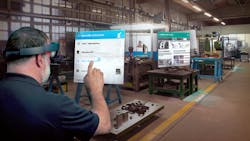There seems to be considerable excitement about the capabilities that augmented reality (AR) can bring to the manufacturing workforce—particularly the idea of maintenance personnel accessing hands-free instructions and remote guidance to help them complete their tasks. But it’s important to keep in mind that not all AR is created equal.
Upskill, an AR software developer, has announced that its Skylight platform is now available for public early access on Microsoft HoloLens. This means that the software platform that previously supported an assisted-reality version of AR on mobile devices is evolving to be a multi-experience platform covering mixed-reality scenarios on HoloLens. “What we are doing with the Skylight for HoloLens is we’re evolving that experience to be more immersive,” said Jay Kim, Upskill’s chief strategy officer.
In its broadest sense, AR is any experience that enhances the user’s real-world context. Within that, there are subdomains along a spectrum of capabilities. With assisted-reality wearables, the effect is similar to holding a 7-inch tablet at arm’s length, with just a single fixed screen in your view, Kim explained. Examples of monocular hardware that Skylight has been available on previously include Glass Enterprise Edition, Vuzix M300 and RealWear HMT-1/Z1.
The technology was focused on enabling hands-free work in the smallest and lightest form factors, Kim noted. Some applications might call for a more robust experience, however. “It is a relatively small screen, so if you’re working on a particularly complex task, assisted reality has inherent limitations, where you could only browse one type of content at a time—whether that’s your work instructions, or it’s a video, or it’s a photo, or it’s a remote assistance session with someone else,” he said. “Because of the relatively small screen, it’s difficult for the system to convey all kinds of different types of content.”
HoloLens, with its binocular technology, provides mixed reality, which is on the more immersive end of the AR spectrum. Not only does it provide a larger screen for placing more open windows, it provides depth as well, enabling users to move instructions backwards or forwards as needed. This is particularly relevant for hands-on workers completing complex tasks in manufacturing, maintenance and repair, as well as for on-the-job training.
“With Skylight for HoloLens, you can place different windows all around you so that, for example, if you’re fixing a piece of equipment or building something, you can have the instruction manuals or your SOP in a PDF format that is right in your line of sight,” Kim said. “And then if you turn your head slightly to the left, you might also have access to reference videos, for example, that could be giving you step-by-step video while that work is being done.”
Skylight’s spatial content placement gives users the ability to place, move and resize digital content in the real world and reference it hands-free while completing their work. They can also simultaneously visualize, resize, interact with and cross-reference numerous sources of content in one, large screen.
To see Skylight for HoloLens in action, see the video below or watch on YouTube.
“The problem that we’re trying to solve for is a lot of wasted motion that’s happening on the factory floor, with people having to go and refer to all kinds of different pieces of information, as well as stopping to go and type information, say, on a laptop or a nearby workstation as they’re performing work,” Kim said. “Now users have instant access to all of those capabilities. That’s the fundamental benefit that Upskill has been working with our customers to unlock for the eight years that we’ve been in business.”
Important in all of this, Kim said, is the fact that manufacturers are able to use the content that they already own—engineering drawings, work instructions, reference manuals, standard procedures, etc.—things that people are already using in printed form or on PCs. “This is all content that businesses own and Skylight can integrate to your existing process automation systems as well.”
All of the features available with Skylight—including enterprise scalability, security and the ability to seamlessly integrate with virtually any system or database—can be leveraged across multiple device types, including smart glasses and mixed-reality headsets, such as HoloLens.

